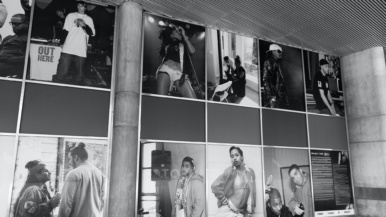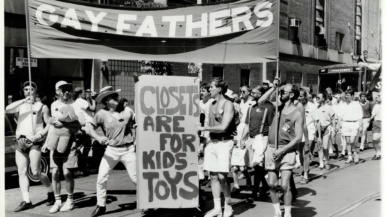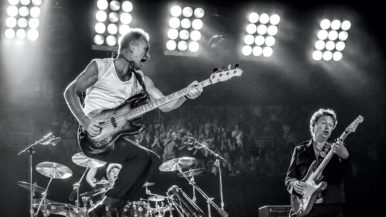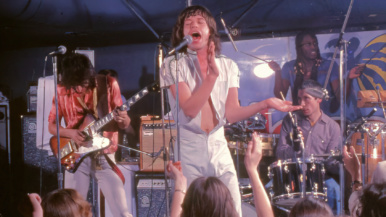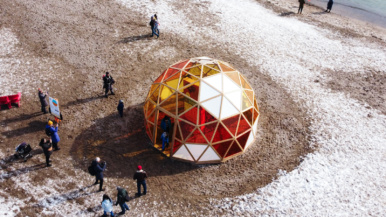Nirvana, Soundgarden and 12 more vintage photos from Toronto’s underground music scene

From 1987 to 1992, music journalist Phil Saunders and photographer Derek von Essen were essentially living in a a never-ending rock show. Night after night, they stomped off to Lee’s Palace, the Silver Dollar or the defunct Apocalypse Club to catch the buzziest new bands. Recently, they dug deep into their past to produce No Flash, Please!, a definitive volume of old photographs and oral histories from Toronto’s underground music scene. We asked them to share the stories behind some of our favourite shots.

Nirvana
Lee’s Palace, April 16, 1990
Saunders: “There was hardly anyone at this show. I was already a huge Nirvana fan—that guy in the back in a leather jacket and a white T-shirt, that’s me. I ran upstairs to Dance Cave, grabbed a bunch of people and said, ‘You gotta see this.’ The crowd was typically cool, and Kurt was pissed. He started grabbing beer bottles and throwing them at the stage. The first one hit the crash cymbal and broke into a million pieces. I like to joke that that’s when Chad Channing, the drummer, decided he didn’t want to be part of Nirvana any more. It wouldn’t surprise me if they didn’t get paid that night. It was like watching a star be born. Everybody was all, ‘Holy shit.’ Of course, Nirvana came back about a year later and played at the Opera House, where Kurt was traipsed around like Cleopatra.”

Soundgarden
Apocalypse Club, November 4, 1989
Saunders: “The atmosphere at this show was absolutely electric. Soundgarden was enormous. They drew on the woodsy, redneck side of Seattle, and they helped innovate it, merging the big sound of Zeppelin and Sabbath with noise, cascading feedback and Chris Cornell’s absolutely operatic voice. I remember interviewing Cornell after their album Temple of the Dog came out. I was blown away to find out that he’d never taken a voice lesson. I thought, ‘This guy’s going to blow his voice out by the time he’s 30.’”

Ranee Lee
Club Rhythm, June 3, 1988
Von Essen: “Ranee Lee starred in a dinner-theatre play about Billie Holiday’s life. This is not the type of stuff I normally shoot. I was lucky to grab this picture—I was seated on as stool by the bar. The paper I worked for said the photos were too dark and shelved them, but I was startled to find this shot, because this is such a classic Billie Holiday pose.”

King Cobb Steelie
Rivoli, October 11, 1991
Saunders: “Guitarist Kevan Byrne, in the foreground, was in a band called Heimlich Manoeuvre, which opened for Nirvana at Lee’s Palace. He famously said, ‘I knew [the grunge scene] was all over when Nevermind came out.’ King Cobb Steelie, a southern Ontario band, bridged the gap between the dub sound and American indie rock. They were the alternative to the alternative. When alternative music was being commodified and turned into sections at HMV, their music was different.”

Chesterfield Kings
Silver Dollar, January 29, 1988
Von Essen: “The Chesterfield Kings rocked a ’60s look. They were friendly and fun, much like The Fleshtones from New York. The lead singer, Greg Prevost, would often point the mic at someone in the audience to get them to sing backup. Seconds before this photo was taken, I think he was offering it to someone right beside me. I’m not sure if he’s making that face because he’s thinking, ‘God damn, here’s that guy with the camera again!’”

Gaye Bykers on Acid
Silver Dollar, April 14, 1988
Von Essen: “This was downstairs at the Silver Dollar, where ventilation was horrible and everyone was always sweaty. The band’s sound was loud and aggressive, and their lead singer had no problem sticking his mug in my face all the time. They were British and their jokes didn’t really land, so they didn’t really seem the most approachable.”

Ten Commandments
Silver Dollar, February 19, 1988
Saunders: “Their singer, James Booth, is one of my heroes. He was one of the first people to interview Nirvana. He had no resources or anybody helping him—in fact, the day he did the interview, his bosses took away his camera. Sure enough, his interview with Nirvana is now legendary. He’s the guy who ‘got’ Nirvana before they were jaded and pissed off about being rock stars.”

Kristi Rose and the Midnight Walkers
Silver Dollar, May 7, 1988
Von Essen: “She had such an amazing stage presence, like an entertainer from the ’50s or ’60s. I’ve never heard pipes like that. People were wallflowers at this show so I was able to get up close. She was comfortable in her own skin and played to the audience—she didn’t engage with me, so I was able to shoot her as though I was invisible.”

The Dundrells
Rivoli, June 11, 1988
Saunders: “The Dundrells had a huge reputation. They were the seminal Toronto rock band of the day. They played a lot of covers, and many songs I know because The Dundrells performed them. They played our book’s release party in May. They hadn’t played together in 30 years, but we immediately said, ‘Wow, I forgot how great this was!’”

Shadowy Men on a Shadowy Planet
Rivoli, October 14, 1988
Von Essen: “Shadowy Men made music that could take you somewhere else. This particular night was the band’s anniversary party—their fourth, I think. It’s one of the strongest, most vibrant photos I got of them.”

Rocktopus
Slither Club, June 10, 1989
Saunders: “We all grew up listening to ’70s rock. Rocktopus emerged from that. They were a little bit of a flash in the pan—a punk-funk band that only really put out one record.”

Mudhoney
Apocalypse Club, October 24, 1989
Saunders: “We didn’t really think of Mudhoney as rock stars. They were just another one of the bands that we knew and we loved. But it’s impossible to talk about the scene in Seattle without discussing Mudhoney. It’s impossible to overstate how important they were. It wasn’t about being famous; it was about creativity.”

Scott B. Sympathy
Slither Club, December 8, 1989
Saunders: “This was a Toronto supergroup—everyone in the band was a great musician. Ian Blurton, the guy on the far left, is a legendary self-taught musician and producer. He was at every show I was at. He was a huge fan of Scott B., a Neil Young–type songwriter from Brantford. He put this band together with the best of the best.”
